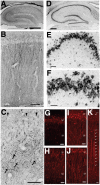Localization and targeting of voltage-dependent ion channels in mammalian central neurons
- PMID: 18923186
- PMCID: PMC2587220
- DOI: 10.1152/physrev.00002.2008
Localization and targeting of voltage-dependent ion channels in mammalian central neurons
Abstract
The intrinsic electrical properties and the synaptic input-output relationships of neurons are governed by the action of voltage-dependent ion channels. The localization of specific populations of ion channels with distinct functional properties at discrete sites in neurons dramatically impacts excitability and synaptic transmission. Molecular cloning studies have revealed a large family of genes encoding voltage-dependent ion channel principal and auxiliary subunits, most of which are expressed in mammalian central neurons. Much recent effort has focused on determining which of these subunits coassemble into native neuronal channel complexes, and the cellular and subcellular distributions of these complexes, as a crucial step in understanding the contribution of these channels to specific aspects of neuronal function. Here we review progress made on recent studies aimed to determine the cellular and subcellular distribution of specific ion channel subunits in mammalian brain neurons using in situ hybridization and immunohistochemistry. We also discuss the repertoire of ion channel subunits in specific neuronal compartments and implications for neuronal physiology. Finally, we discuss the emerging mechanisms for determining the discrete subcellular distributions observed for many neuronal ion channels.
Figures






References
-
- Agnew WS, Miller JA, Ellisman MH, Rosenberg RL, Tomiko SA, Levinson SR. The voltage-regulated sodium channel from the electroplax of Electrophorus electricus. Cold Spring Harb Symp Quant Biol. 1983;48(Pt 1):165–179. - PubMed
-
- Ahlijanian MK, Westenbroek RE, Catterall WA. Subunit structure and localization of dihydropyridine-sensitive calcium channels in mammalian brain, spinal cord, and retina. Neuron. 1990;4:819–832. - PubMed
-
- Albensi BC, Ryujin KT, McIntosh JM, Naisbitt SR, Olivera BM, Fillous F. Localization of [125I]omega-conotoxin GVIA binding in human hippocampus and cerebellum. Neuroreport. 1993;4:1331–1334. - PubMed
-
- Albrecht B, Weber K, Pongs O. Characterization of a voltage-activated K-channel gene cluster on human chromosome 12p13. Receptors Channels. 1995;3:213–220. - PubMed
-
- An WF, Bowlby MR, Betty M, Cao J, Ling HP, Mendoza G, Hinson JW, Mattsson KI, Strassle BW, Trimmer JS, Rhodes KJ. Modulation of A-type potassium channels by a family of calcium sensors. Nature. 2000;403:553–556. - PubMed
Publication types
MeSH terms
Substances
Grants and funding
LinkOut - more resources
Full Text Sources
Other Literature Sources
Molecular Biology Databases

